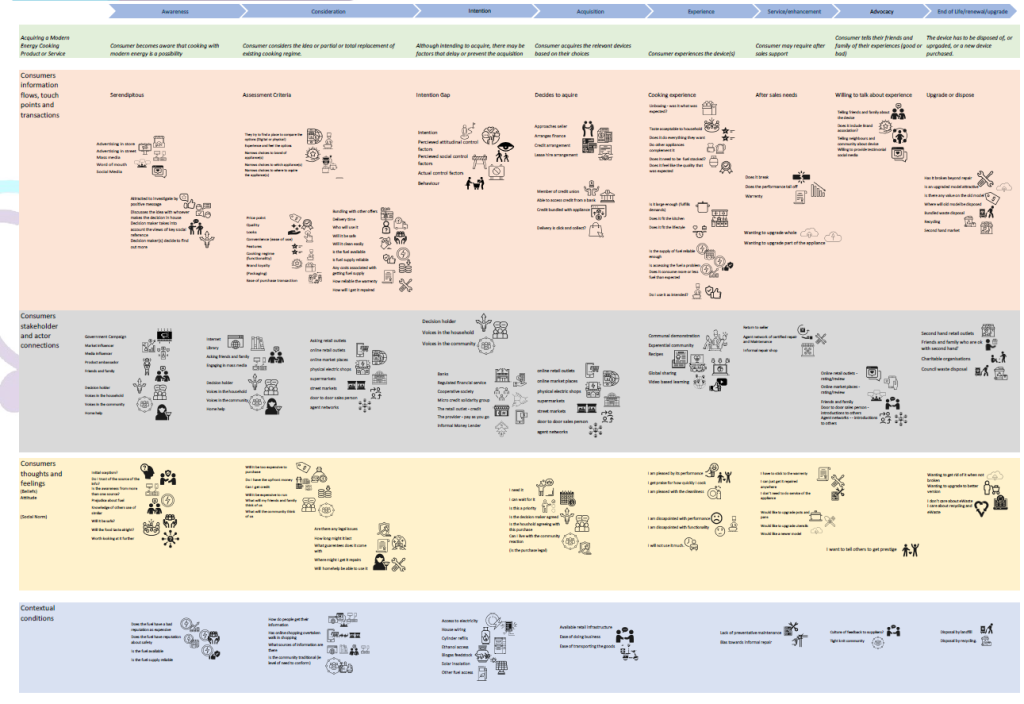- Date
- 10th March 2022
- Categories
By Dr Simon Batchelor (Gamos Ltd. / Loughborough University).

This working paper describes a consumer or user journey for someone accessing modern energy cooking services. Consumer Journeys are often specific to a retailer of a product or provider of a service, and are used to ensure that the user can access the products or services with ‘minimal pain points’. They are generally a specific management tool that enables companies to determine where best to apply resources. They can describe everything from a journey through a website (and whether it leads easily to online purchase), to the experience entering a supermarket.
In this paper however, we consider how households in Africa and developing Asia might consider changing from their existing cooking equipment (majority being wood and charcoal), to accessing a modern energy cooking service (either equipment, or a pay as you go service). As such it is a generic speculative journey, and this framework is presented as a starter for where the joys and pains of that journey might be. We hope it provides a framework for those promoting modern energy cooking services whether as a specific product or service. The journey is populated with insights generated across the MECS research, including Discrete Choice Modelling, Cooking Diary evidence, focus groups, stakeholder workshops, among others, and from the wider literature on consumer journeys and from relevant national data (e.g. Multi Tier Framework Data (ESMAP), National DHS and LSMS data (World Bank+). Together they provide insights as to how people set their criteria and make choices.
For us we chose the following stages for the consumer journey:
- Awareness – Consumer becomes aware that cooking with modern energy is a possibility
- Consideration – Consumer considers the idea of partial or total replacement of existing cooking regime.
- Intention – Consumer makes a decision to, (ie intends to) acquire.
- Acquisition – Consumer acquires the relevant devices or services based on their choices
- Experience – Consumer experiences the device(s)/service
- Service/Enhancement – Consumer may require after sales support
- Advocacy – Consumer tells their friends and family of their experiences (good or bad)
- End of life – The device has to be disposed of, or upgraded, or a new device purchased.
For each of these stages we consider:
- The consumer ‘moments’, i.e. the information flows, touch points, and transactions,
- The consumer’s connections (networks, the ‘who’ of the story),
- The consumer’s thought and feelings, and
- The context (or control factors) within which the journey takes place.
Walking through the consumer journey illustrates and draws attention to the myriad of moments which may make or break an acquisition. It is presented as a linear journey but often it is more cyclical as one consumer gets a product or service and advocates with their friends, family, neighbours and strangers, which in turn may prompt a new consumer journey by a new consumer. Or indeed the original consumer may go through the journey again in upgrading their existing appliance or getting an auxiliary or associated appliance.
The overall journey is complex and the above image for this blog is too small to read (and of insufficient quality), however a full quality image is in the working paper. The diagram reads left to right and top to bottom. Across the top the stages are approximated to columns, within which we explore the moments, the connections to people, explore the thoughts and feelings of the consumer and in the last band, make reference to the context and possible control factors
While the stages may be common to most if not all consumers, the exact navigation, i.e. the specific steps, across the diagram will likely vary according to the individual and their household. To complete the paper the five personas identified through discrete choice modelling across 6 countries, are used to describe a typical path across the map, the specific journey for that persona.
We welcome comment on this paper and hope it forms the basis for future discussion, research and planning of integrated modern energy programmes inclusive of clean cooking.